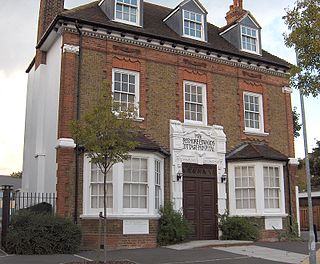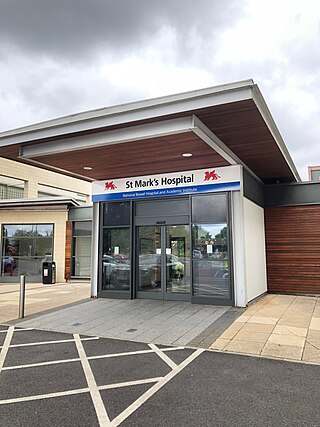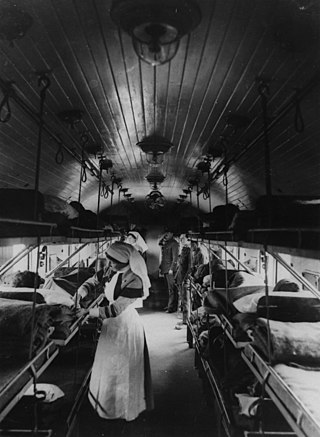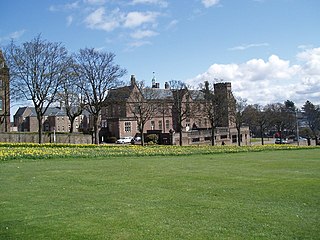
Sydney Hospital is a major hospital in Australia, located on Macquarie Street in the Sydney central business district. It is the oldest hospital in Australia, dating back to 1788, and has been at its current location since 1811. It first received the name Sydney Hospital in 1881.

Saint Mary's Hospital is a hospital in Manchester, England. It is part of Manchester University NHS Foundation Trust. Founded in 1790, St Mary's provides a range of inter-related services specifically for women and children. In 1986, St Mary's Sexual Assault Referral Centre was the first sexual assault referral centre (SARC) to open in the UK.

Royal Brompton Hospital is the largest specialist heart and lung medical centre in the United Kingdom. It is managed by Guy's and St Thomas' NHS Foundation Trust.

North Manchester General Hospital (NMGH) is a large NHS hospital in Crumpsall, North Manchester, England. It is operated by Manchester University NHS Foundation Trust. There is an accident and emergency unit, together with a maternity unit, high dependency unit and a mental health wing. A plan to rebuild the hospital was announced by Boris Johnson in the 2019 General Election campaign, and in November 2020 a £54 million funding bid for improvement works was made by the Trust, Manchester City Council, and Manchester Health and Care Commissioning.

The Ancoats Hospital and Ardwick and Ancoats Dispensary was a large inner-city hospital located in Ancoats, to the north of the city centre of Manchester, England. It was built in 1875, replacing the Ardwick and Ancoats Dispensary that had existed since 1828. The building is now Grade II listed.

Barnes Hospital in Cheadle, Greater Manchester, England, is a former hospital. It is on the border between Manchester and Stockport, near the A34 road in the middle of the complex interchange between Kingsway, the M60 and M56 motorway. The main building is Grade II listed, and lies on green belt land.

The Royal Infirmary of Edinburgh (RIE), often known as the Edinburgh Royal Infirmary (ERI), was established in 1729 and is the oldest voluntary hospital in Scotland. The new buildings of 1879 were claimed to be the largest voluntary hospital in the United Kingdom, and later on, the Empire. The hospital moved to a new 900 bed site in 2003 in Little France. It is the site of clinical medicine teaching as well as a teaching hospital for the University of Edinburgh Medical School. In 1960, the first successful kidney transplant performed in the UK was at this hospital. In 1964, the world's first coronary care unit was established at the hospital. It is the only site for liver, pancreas and pancreatic islet cell transplantation and one of two sites for kidney transplantation in Scotland. In 2012, the Emergency Department had 113,000 patient attendances, the highest number in Scotland. It is managed by NHS Lothian.

A cottage hospital is a mostly obsolete type of small hospital, most commonly found in the United Kingdom.

St Mark's Hospital, The National Bowel Hospital is a hospital in Park Royal, Greater London, England. Managed by London North West University Healthcare NHS Trust, it is the only hospital in the world to specialise entirely in intestinal and colorectal medicine and is a national and international referral centre for intestinal and colorectal disorders. It is the only hospital in the UK, and one of only 14 worldwide, to be recognised as a centre of excellence by the World Organisation of Digestive Endoscopy.

The Territorial Force Nursing Service (TFNS) was established in 1908, part of the reform of the British auxiliary forces introduced by Richard Haldane which created the Territorial Force. Nurses with at least three years of training were able to volunteer for the service, and facilities comprised 23 large buildings earmarked for use as hospitals in the event of war. The TFNS was augmented by the affiliation of Voluntary Aid Detachments. On the outbreak of the First World War, the hospitals were commissioned and up to 2,784 nurses mobilised to staff them. By the end of the war, up to 8,140 nurses had served with the TFNS, 2,280 of them in hospitals and casualty clearing stations abroad. After the war, the TFNS became the Territorial Army Nursing Service in line with the reconstitution of the Territorial Force as the Territorial Army.

Cheadle Royal Hospital is a psychiatric hospital in Heald Green, Greater Manchester, England, built between 1848 and 1849. The main building is Grade II listed.

Dundee Royal Infirmary, often shortened to DRI, was a major teaching hospital in Dundee, Scotland. Until the opening of Ninewells Hospital in 1974, Dundee Royal Infirmary was Dundee's main hospital. It was closed in 1998, after 200 years of operation.
The Manchester Royal School of Medicine has its origins in a medical teaching establishment opened on Pine Street, Manchester, England, by Thomas Turner. Established in 1824, the school added the word Royal in 1836 and in 1872 it was taken over by Owens College, which later became a part of the Victoria University of Manchester.

Walter Whitehead, FRCSE, FRSE, was a surgeon at various hospitals in Manchester, England, and held the chair of Clinical Surgery at the Victoria University of Manchester. He was president of the British Medical Association in 1902. He once claimed that knowledge of anatomy was an impediment to being a good surgeon but was himself a bold, innovative practitioner of international repute. His procedure for excision of the tongue using scissors and his formulation of a related ointment became a standard treatment, as did a procedure he developed for the treatment of haemorrhoids.

Booth Hall Children's Hospital was a children's hospital at Blackley in Manchester. It was managed by Central Manchester University Hospitals NHS Foundation Trust.
Monsall Hospital was a hospital in North Manchester, England.
Edward Mansfield Brockbank MBE was a cardiologist and surgeon closely associated with the Manchester Royal Infirmary. He was a prolific author of medical textbooks and works of medical history and biography and contributed a number of articles to the Dictionary of National Biography.

The Bolton Royal Infirmary was an acute general hospital in Chorley Street, Bolton, Greater Manchester, England.

The Miller General Hospital was a hospital in Greenwich, London from 1884 until 1974. It was developed adjacent to an earlier dispensary, and was the first British hospital designed with circular wards, and one of the first to have an X-ray department.

Margaret Elwyn Sparshott was a British nurse. She was the principal matron of Manchester Royal Infirmary, and of the Territorial Force Nursing Service at Manchester, England. During the First World War, she used 2nd Western General Hospital as a base, and had the assistance of St John Ambulance, the Voluntary Aid Detachment (VADs) and the Red Cross. Within this framework she was responsible for the running of twenty-two large auxiliary hospitals, including the field hospitals for the war wounded, in Stockport, Salford and Manchester. Her duty extended to coping with increased patient numbers during the 1918–1920 flu pandemic.
























